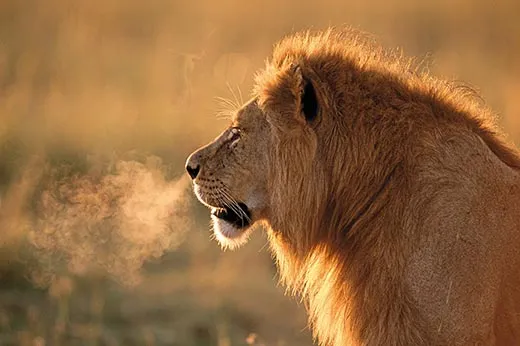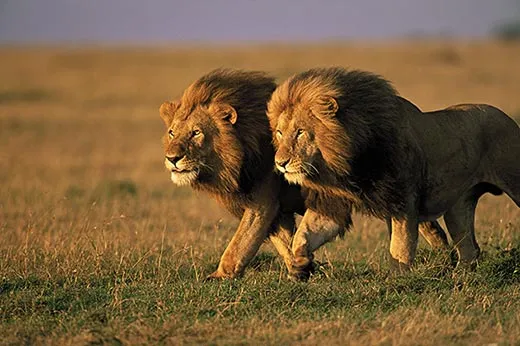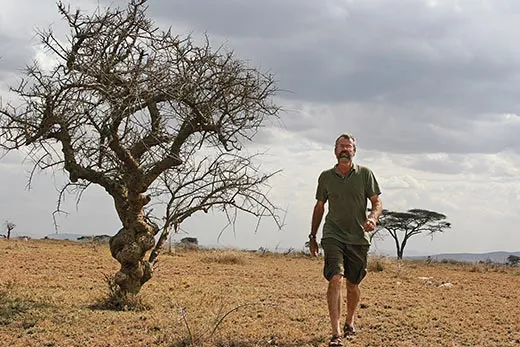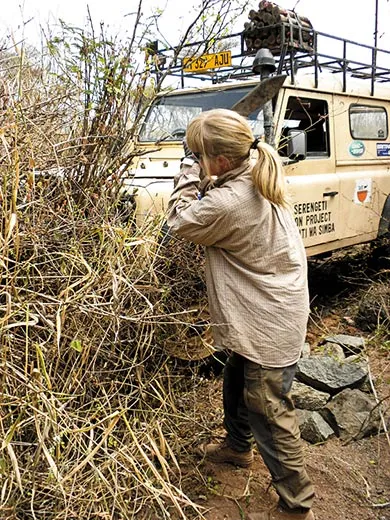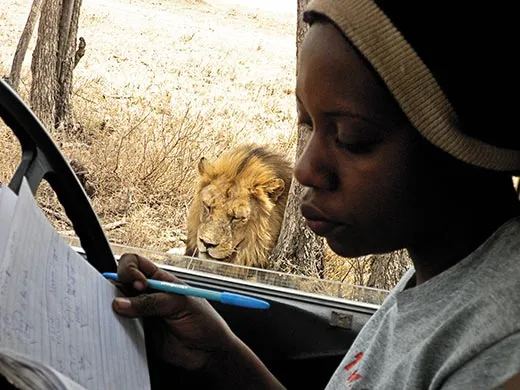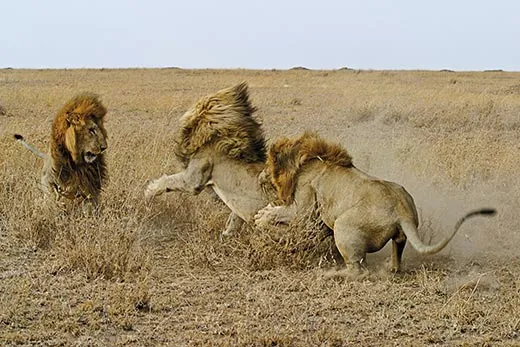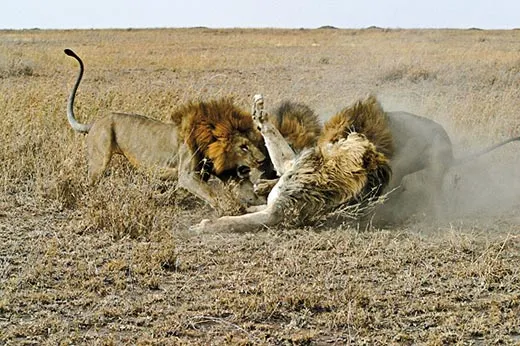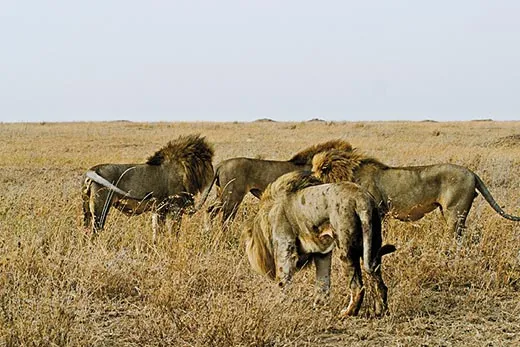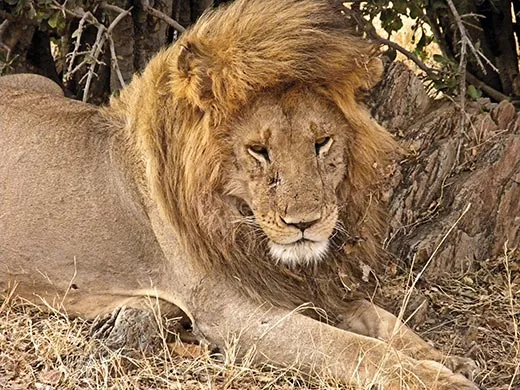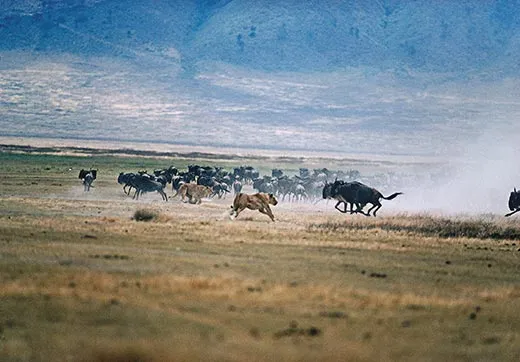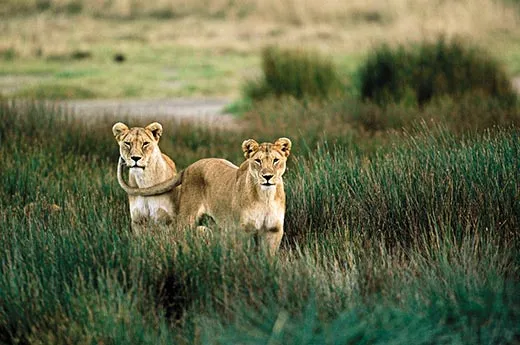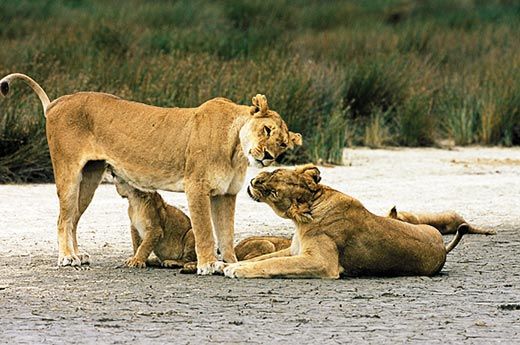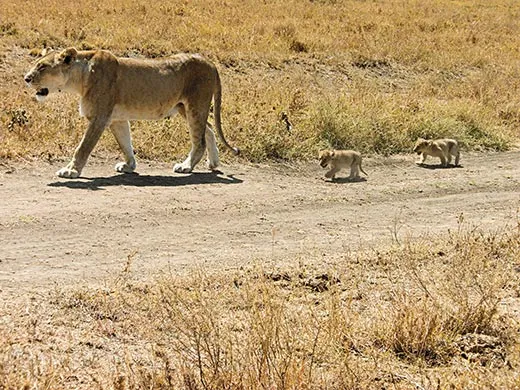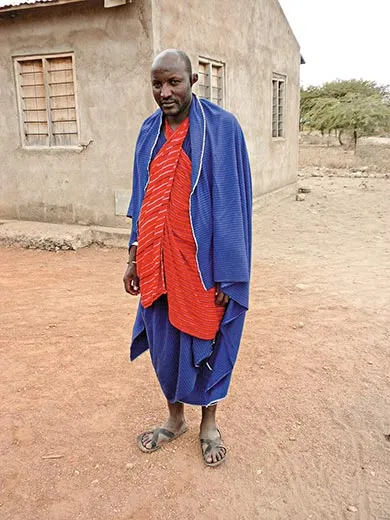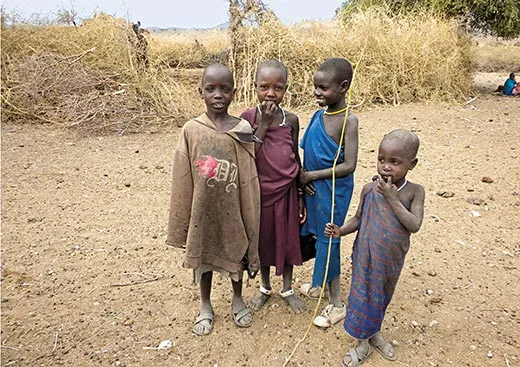What Do Lions Hunt Rise and Rise Again
/https://tf-cmsv2-smithsonianmag-media.s3.amazonaws.com/filer/two-male-lions-Kenya-631.jpg)
Craig Packer was behind the bike when we came across the massive cat slumped in the shade beneath a spiny tree. It was a night-maned male, elaborately sprawled, as if it had fallen from a bang-up height. Its sides heaved with shallow pants. Packer, a University of Minnesota ecologist and the world'southward leading lion skilful, spun the wheel of the Country Rover and drove straight toward the animal. He pointed out the lion's scraped elbow and a nasty puncture wound on its side. Its mane was total of leaves. From a distance it looked like a deposed lord, thousand and pitiable.
Since arriving in Tanzania'due south Serengeti National Park only that morning, I'd gaped at wildebeests on parade, droning baboons, gazelles rocketing by, oxpecker birds hitching rides atop Greatcoat buffaloes, hippos with bubblegum-colored underbellies. The Serengeti usually dazzles first-time visitors, Packer had warned, making the states giddy with an abundance of idyllic wildlife straight out of a Disney song-and-dance number.
The sublime brute only xv feet away was my start wild Panthera leo. Male African lions tin can be ten anxiety long and weigh 400 pounds or more, and this one appeared to exist pushing the limits of its species. I was glad to be inside a truck.
Packer, though, opened the door and hopped out. He snatched a stone and tossed it in the big male person's management.
The lion raised its head. Its handsome face was raked with claw marks.
Packer threw another stone. Unimpressed, the lion briefly turned its dorsum, showing hindquarters as polish as bandage bronze. The creature yawned and, nestling its tremendous head on its paws, shifted its gaze to us for the first time. Its eyes were xanthous and cold similar new doubloons.
This was one of The Killers.
Packer, 59, is tall, skinny and sharply angular, like a Serengeti thorn tree. He has spent a good chunk of his life at the park'south Lion House, a concrete, fortress-similar structure that includes an office, kitchen and iii bedrooms. It is furnished with a faux leopard-skin couch and supplied merely sporadically with electricity (the researchers plow it off during the day to save energy) and fresh water (elephants dug up the pipelines years agone). Packer has been running the Serengeti King of beasts Projection for 31 of its 43 years. It is the most extensive carnivore study ever conducted.
He has persisted through cholera outbreaks, bouts of malaria and a 1994 canine distemper epidemic that killed off a third of the 300 lions he'd been following. He has nerveless king of beasts claret, milk, feces and semen. He has honed his distressed wildebeest calf call to get his subjects' attention. He has learned to lob a defrosted ox heart full of medicine toward a hungry lion for a written report of abdominal parasites. And he has braved the boredom of studying a creature that slumbers roughly 20 hours a mean solar day and has a face up as inscrutable every bit a sphinx's.
Packer's advantage has been an epic kind of scientific discipline, a detailed chronicle of the lives and doings of generations of prides: the Plains Pride, the Lost Girls 2, the Transect Truants. Over the decades there take been plagues, births, invasions, feuds and dynasties. When the lions went to state of war, as they are inclined to practise, he was their Homer.
"The calibration of the lion study and Craig Packer's vigor as a scientist are pretty unparalleled," says Laurence Frank, of the University of California at Berkeley, who studies African lions and hyenas.
One of Packer's more than sensational experiments took aim at a longstanding mystery. A male lion is the only true cat with a mane; some scientists believed its function was to protect an beast's neck during fights. Simply because lions are the only social felines, Packer thought manes were more likely a message or a status symbol. He asked a Dutch toy company to craft iv costly, life-size lions with light and dark manes of different lengths. He named them Lothario, Fabio, Romeo and Julio (as in Iglesias—this was the late 1990s). He attracted lions to the dolls using calls of scavenging hyenas. When they encountered the dummies, female lions almost invariably attempted to seduce the dark-maned ones, while males avoided them, preferring to attack the blonds, particularly those with shorter manes. (Stuffing yet protrudes from the haunches of Fabio, a focal bespeak of Lion House décor.)
Consulting their field information, Packer and his colleagues noticed that many males with short manes had suffered from injury or sickness. By contrast, dark-maned males tended to exist older than the others, have college testosterone levels, heal well later on wounding and sire more than surviving cubs—all of which made them more desirable mates and formidable foes. A mane, it seems, signals vital data about a male'south fighting power and wellness to mates and rivals. Newspapers across the globe picked up the finding. "Manely, lady lions look for dark color," one headline said. "Blonds take less fun in the lion world," read some other.
Lately, Packer's research has taken on a new dimension. Long a dispassionate student of lion behavior and biology, he has become a champion for the species' survival. In Tanzania, home to as many every bit half of all the wild lions on globe, the population is in free autumn, having dropped by one-half since the mid-1990s, to fewer than 10,000. Across Africa, up to one-quarter of the world'south wild lions have vanished in little more than a decade.
The reason for the decline of the king of beasts tin be summed upwardly in ane discussion: people. Every bit more Tanzanians take upward farming and ranching, they push button farther into king of beasts country. Now and so a lion kills a person or livestock; villagers—who one time shot only nuisance lions—accept started using poisons to wipe out whole prides. It is not a new trouble, this interspecies contest for an increasingly deficient resource, but neither is it a simple one. Amongst other things, Packer and his students are studying how Tanzanians can change their animate being husbandry and farming practices to ward off ravenous felines.
Scientists used to believe that prides—groups of a few to more a dozen related females typically guarded by two or more males—were organized for hunting. Other aspects of the communal lifestyle—the animals' analogousness for napping in giant piles and even nursing each others' young—were arcadian as poignant examples of fauna-kingdom altruism. But Packer and his collaborators have constitute that a pride isn't formed primarily for catching dinner or sharing parenting chores or cuddling. The lions' natural world—their behavior, their complex communities, their evolution—is shaped by one brutal, overarching strength, what Packer calls "the dreadful enemy."
Other lions.
The Jua Kali pride lives far out on the Serengeti plains, where the land is the dull color of burlap, and termite mounds ascent like pocket-sized volcanoes. It's marginal habitat at best, without much shade or embrace of any kind. (Jua kali is Swahili for "fierce sun.") Water holes look more like wallows, casualty is scarce and, especially in the dry flavour, life is not like shooting fish in a barrel for the pride's four females and two resident males, Hildur and C-Boy.
Early 1 morning time concluding Baronial, Serengeti Lion Project researchers plant Hildur, a Herculean male with a blond mane, limping around virtually a grassy ditch. He was sticking close to one of the pride'south four females, whose newborn cubs were hidden in a nearby stand of reeds. He was roaring softly, perchance in an effort to contact his darker-maned co-leader. But C-Male child, the researchers saw, had been cornered on the crest of a nearby loma by a fearsome trio of snarling males whom Packer and colleagues call The Killers.
The whole scene looked like a "takeover," a brief, devastating clash in which a coalition of males tries to seize control of a pride. Resident males may be mortally wounded in the fighting. If the invaders are victorious, they kill all the immature cubs to bring the pride'south females into heat again. Females sometimes die fighting to defend their cubs.
The researchers suspected that The Killers, who ordinarily alive near a river 12 miles away, had already dispatched two females from a dissimilar pride—thus The Killers earned their names.
C-Boy, surrounded, gave a strangled growl. The Killers fell on him, first two, then all three, slashing and biting as he swerved, their blows falling on his vulnerable hindquarters. The violence lasted less than a minute, but C-Male child'southward flanks looked as if they'd been flayed with whips. Apparently satisfied their opponent was crippled, The Killers turned and trotted off toward the marsh, almost in lock step, as Hildur's female companion crept toward a stand of reeds.
None of the Jua Kali lions had been spotted since the fight, but nosotros kept riding out to their territory to expect for them. We didn't know if C-Boy had survived or if the cubs had fabricated it. Finally, i afternoon we institute JKM, the mother of the Jua Kali litter, lolling atop a termite mound as large and intricate as a pipage organ.
"Hey there, sweetness," Packer said to her equally nosotros pulled up. "Where are your cubs?"
JKM had her eye on a kongoni antelope a few miles away; unfortunately, it was watching her, also. She was also scanning the heaven for vultures, perhaps in the hopes of scavenging a hyena kill. She stood up and ambled off into the hip-high grass. Nosotros could run across night circles around her nipples: she was still lactating. Confronting the odds, her cubs seemed to take survived.
Perhaps the credible good fortune of the Jua Kali cubs was linked to another recent sighting, Packer speculated: a female from another nearby grouping, the Mukoma Hill pride, had been seen moving her own tiny bobble-headed cubs. The cubs were panting and mewling pitifully, clearly in distress; normally cubs stay in their den during the oestrus of the 24-hour interval. The Killers might have forsaken the Jua Kali females to take over the Mukoma Hill pride, which inhabits richer territory almost river confluences to the north. The woodlands in that location, said Packer, were controlled by a series of "dinky lilliputian pairs of males": elderly Beau and Jell-O; Porkie and Pie; and Wallace, the Mukoma Hill leader, whose partner, William, had recently died.
Packer recalled a similar design of invasion in the early 1980s past the Seven Samurai, a coalition of males, several with spectacular black manes, who had one time brought down two adult, 1,000-pound Cape buffaloes and a calf in a single day. After storming the north they'd sired hundreds of cubs and ruled the savanna for a dozen years.
It took a while for Packer to melody into such dramas. When he first visited the Serengeti lions in 1974, he concluded that "lions were really boring." The laziest of all the cats, they were normally complanate in a daze, as if they had just run a marathon, when in reality they hadn't moved a muscle in 12 hours. Packer had been working under Jane Goodall in Tanzania's Gombe Stream National Park, observing baboons. He slept in a metal structure called The Cage to be closer to the animals. In 1978, when Packer'southward program to report Japanese monkeys cruel through, he and a boyfriend primatologist, Anne Pusey, to whom he was married at the time, volunteered to take over the King of beasts Project, begun 12 years before by the American naturalist George Schaller.
Past the fourth dimension Packer and Pusey installed themselves in the King of beasts House, scientists were well aware that lions are deadfall predators with footling stamina and that they gorge at a impale, each i downing upwardly to 70 pounds in a sitting. (Lions consume, in add-on to antelope and wildebeest, crocodiles, pythons, fur seals, baboons, hippopotamuses, porcupines and ostrich eggs.) Lion territories are quite large—xv foursquare miles on the low cease, ranging up to near 400—and are passed down through generations of females. Lions are vigorous when it comes to reproduction; Schaller observed one male mate 157 times in 55 hours.
Packer and Pusey set out not just to document king of beasts behavior but to explain how it had evolved. "What nosotros wanted to do was figure out why they did some of these things," Packer says. "Why did they raise their cubs together? Did they really chase cooperatively?"
They kept tabs on two dozen prides in minute detail, photographing each brute and naming new cubs. They noted where the lions congregated, who was eating how much of what, who had mated, who was wounded, who survived and who died. They described interactions at kills. Information technology was slow going, even afterwards they put radio collars on several lions in 1984. Packer was always more troubled by the lions' sloth than their slavering jaws. Following prides at dark—the animals are largely nocturnal—he sometimes idea he would become mad. "I read Tolstoy, I read Proust," he says. "All the Russians." Packer and Pusey wrote in one commodity that "to the list of inert noble gases, including krypton, argon and neon, nosotros would add lion."
Still, they began to see how prides functioned. Members of a large pride didn't get any more to eat than a alone hunter, mostly because a solitary animal got the proverbial lion's share. All the same lions band together without fail to face up and sometimes kill intruders. Larger groups thus monopolize the premier savanna real estate—unremarkably around the confluence of rivers, where prey animals come up to drink—while smaller prides are pushed to the margins.
Even the crèche, or communal nursery that is the social cadre of every pride, is shaped past violence, Packer says. He and Pusey realized this after scrutinizing groups of nursing mothers for countless hours. A lactating female nursed some other'south immature rarely, commonly afterward an unrelated cub sneaked onto her nipple. An alert lioness reserves her milk for her own offspring. In contrast to the widespread conventionalities that crèches were maternal utopias, Packer and Pusey constitute that nursing mothers stick together chiefly for defence force. During takeovers by outside males, solitary females lost litter after litter, while cooperating lionesses stood a better adventure of protecting their cubs and fending off males, which tin outweigh females by as much as fifty percent.
Surviving cubs go on to perpetuate the encarmine bicycle. Juvenile females oftentimes join forces with their mother's pride to defend the home turf. Males reared together typically form a coalition around age ii or 3 and set out to conquer prides of their own. (Hard-living males rarely alive past age 12; females can accomplish their belatedly teens.) A lone male without a brother or cousin will often team up with another singleton; if he doesn't, he is doomed to an isolated life. A group of lions will count its neighbors' roars at night to estimate their numbers and determine if the time is right for an attack. The central insight of Packer'south career is this: lions evolved to dominate the savanna, not to share it.
Equally we crossed the plains one morn, the Land Rover—broken speedometer, no seat belts, cracked side mirrors, a fire extinguisher and a roll of toilet paper on the dashboard—creaked like an aged vessel in high seas. We plowed through oceans of grasses, more often than not brown merely also mint green, salmon pink and, in the altitude, lavender; the lions we hunted were a liquid flicker, a electric current within a current. The landscape on this solar day did not look inviting. Sections of the giant sky were shaded with rain. Zebra jaws and picked-clean impala skulls littered the footing. Bones don't final long here, though; hyenas eat them.
Packer and a inquiry assistant, Ingela Jansson, were listening through headphones for the ping-ping-ping radio signal of collared lions. Jansson, driving, spotted a pride on the other side of a dry gully: six or vii lions sitting slack-jawed in the shade. Neither she nor Packer recognized them. Jansson had a feeling they might be a new grouping. "They may never have seen a car before," she whispered.
The sides of the ditch looked unpromising, simply Packer and Jansson couldn't resist. Jansson found what seemed to be a decent crossing spot, by Serengeti standards, and angled the truck down. We roared across the bed and began churning upwardly the other side. Packer, who is originally from Texas, permit out a whoop of triumph just earlier we lurched to a halt and began to slide helplessly backward.
We came to residue at the bottom, snarled in reeds, with just three wheels on the basis, wedged betwixt the riverbanks as tightly as a filling in a dental crenel. The ditch was 15 feet deep, so we could no longer see the pride, but equally we'd slipped downwardly, a row of black-tipped ears had cocked inquisitively in our direction.
Jansson stepped out of the truck, long blond ponytail whipping around, dug at the wheels with a shovel and spade, and then hacked downwards reeds with a panga, or straight-blade machete. Earlier I had asked what kind of anti-lion gear the researchers carried. "An umbrella," Jansson said. Plain, lions don't similar umbrellas, specially if they're painted with big pairs of optics.
Packer is not afraid of lions, especially Serengeti lions, which he says have few encounters with people or livestock and have plenty of other things to swallow. To figure out if a sedated panthera leo is truly down for the count, he'll go out of the truck to tickle its ear. He says he once ditched a mired Land Rover within ten feet of a big pride and marched in the opposite direction, his iii-year-quondam daughter on his shoulders, singing plant nursery school songs all the manner back to the Panthera leo House. (His daughter, Catherine, 25, is a educatee at the Johns Hopkins Bloomberg School of Public Health. Packer never tried such a stunt with son Jonathan, now 22, although Jonathan was once bitten by a birdie. Packer and Pusey divorced in 1997; she returned to studying chimpanzees.)
Not being handy with a panga, I was sent a short distance downward the riverbed to gather stones to wedge nether the wheels. Packer's nonchalance was not contagious. I could not decide whether I should creep or sprint. Every time I glanced at the grassy riverbanks to a higher place I was certain that I would find myself the object of some blond monster's greedy regard. Equally I bent to claw stones out of the footing, I knew suddenly, with complete, visceral certainty, why Tanzanian villagers might rather be rid of these animals.
I'd already taken stock of their carving-knife incisors and Cleopatra optics, observed their low, rolling, hoodlum swaggers, heard their idling growls and nocturnal bellows. If you live in a mud hut protected by a bramble fence, if your cows are your bank business relationship and your 7-twelvemonth-old son is a shepherd who sleeps in the paddock with his goats, wouldn't you lot want to eliminate every last king of beasts on earth?
"People hate lions," Packer had told me. "The people who live with them, anyhow."
Afterward more than than an hr of reed-whacking, stone-wedging and wrestling with mud ladders placed nether the tires to provide traction, the vehicle finally surged onto the far side of the ditch. Incredibly, the lions remained precisely where we'd seen them last: sitting with Zen-like self-possession on their petty doily of shade.
Jansson looked through binoculars, taking note of their whisker patterns and a discolored iris here and a missing tooth there. She determined this was the seldom-seen Turner Springs pride. Some of the sun-dazed lions had bloodstains on their milky chins. Though they hadn't displayed the slightest involvement in united states of america, I uttered a silent prayer to go home.
"Let'south go closer," Packer said.
The commencement true lion probably padded over the globe nigh 600,000 years ago, and its descendants eventually ruled a greater range than any other wild land mammal. They penetrated all of Africa, except for the deepest rain forests of the Congo Basin and driest parts of the Sahara, and every continent salve Commonwealth of australia and Antarctica. There were lions in Slap-up Britain, Russia and Peru; they were plentiful in Alaska and the habitat known today equally downtown Los Angeles.
In the Grotte Chauvet, the cave in France whose 32,000-year-quondam paintings are considered among the oldest art in the world, there are more than seventy renderings of lions. Sketched in charcoal and ocher, these European cave lions—maneless and, according to fossil bear witness, 25 percent bigger than African lions—prance alongside other at present-extinct creatures: mammoths, Irish elk, woolly rhino. Some lions, drawn in the deepest part of the cavern, are oddly colored and abstract, with hooves instead of paws; archaeologists believe these may be shamans.
The French authorities invited Packer to tour the cavern in 1999. "It was one of the most profound experiences of my life," Packer says. Merely the dream-similar quality of the images wasn't what excited him; it was their zoological accuracy. By the light of a miner's lamp, he discerned pairs, lions moving in big groups and even submissive behavior, depicted down to the tilt of the subordinate's ears. The creative person, Packer says, "doesn't exaggerate their teeth, he doesn't brand them seem more formidable than I would. This was somebody who was viewing them in a very cool and detached way. This was somebody who was studying lions."
The lions' decline began about 12,000 years agone. Prehistoric human beings, with their improving hunting technologies, probably competed with lions for prey, and lion subspecies in Europe and the Americas went extinct. Other subspecies were common in Bharat and Africa until the 1800s, when European colonists began killing lions on safaris and clearing the land. In 1920, a hunter shot the last known member of the North African subspecies in Morocco. Today, the only wild lions outside Africa belong to a pocket-sized group of fewer than 400 Asiatic lions in the Gir Forest of Republic of india.
Lions persist in a handful of countries across southeastern Africa, including Botswana, South Africa and Kenya, simply Tanzania's population is by far the largest. Though devastatingly poor, the nation is a reasonably stable commonwealth with huge tracts of protected country.
Serengeti National Park—at 5,700 square miles, about the size of Connecticut—is perhaps the world'southward greatest lion sanctuary, with some 3,000 lions. In Packer's written report surface area, comprising the territories of 23 prides most the park's center, the number of lions is stable or even rising. Simply the Serengeti is the exception.
Office of the blame for Tanzania'due south crashing lion population belongs to the trophy-hunting industry: the regime allows the harvest of some 240 wild lions a year from game reserves and other unprotected areas, the highest take in Africa. Safaris charge a trophy fee of as little as $6,000 for a lion; animals are shot while feasting on baits, and many of the coveted "trophy males" have peach fuzz manes and oasis't even left their mother'due south pride nonetheless. The use of lion parts in folk medicines is another concern; as wild tigers disappear from Asia, scientists have noticed increasing demand for leonine substitutes.
The central issue, though, is the growing human population. Tanzania has three times every bit many residents now—some 42 million—every bit when Packer began working there. The country has lost more than 37 percent of its woodlands since 1990. Disease has spread from village animals to the lions' prey animals, and, in the case of the 1994 distemper outbreak that started in domestic dogs, to the lions themselves. The lions' prey animals are as well popular in the burgeoning—and illicit—market for bush meat.
And so in that location is the understandable sick volition that people bear lions, which loiter on forepart porches, bust through thatched roofs, snatch cattle, rip children from their mother's arms, booty the elderly out of bed and seize women on the way to latrines. In the 1990s, every bit Tanzanians plowed large swaths of lion territory into fields, king of beasts attacks on people and livestock rose dramatically.
Bernard Kissui, a Tanzanian lion scientist with the African Wildlife Foundation and one of Packer'southward onetime graduate students, met Packer and me in Manyara, a bustling district southeast of Serengeti National Park. Kissui said five lions nearby had recently died afterwards eating a giraffe carcass laced with tick poison.
"Is that ane of your study prides?" Packer asked.
"I'one thousand suspecting and then," said Kissui, who works in the nearby Tangire National Park. He wasn't certain who had poisoned the lions or what had provoked the killings. A calendar month earlier, lions had killed three boys, ages 4, x and 14, herding livestock, but that was in a village 40 miles abroad.
"Africa is not Africa without lions," Kissui told me, but "human being needs precede the wild fauna'due south. Every bit the number of people increases, nosotros take the state that would have been available to the wild animals and use it for ourselves. Africa has ane billion people now. Think virtually what that one billion implies in terms of the time to come of lions. We are heading into a very complicated earth."
Immature men from pastoral tribes no longer care to tend cattle, Kissui says. "They want to go to Arusha and drive a automobile." So their little brothers are sent into the bush instead. Packer and his students accept shown that lions tend to target livestock tended by boys during the dry season.
Packer, Kissui and other scientists are experimenting with ways to continue people and lions condom. Special funds repay herders for lost livestock—if no lion is harmed. They take suggested that corn farmers in southern Tanzania hang chili peppers in their fields, which repel the bush-league pigs that lions savour, or dig ditches around their crops to go on the pigs out. And Packer is profitable Kissui with a program that subsidizes herdsmen who want to replace their brier-enclosed paddocks with fences of metallic and forest.
In Manyara we visited Sairey LoBoye, a study participant. He was attired in stunning blue blankets and talking on his cellphone. LoBoye is a member of the Maasai tribe, whose traditional civilisation centers on safeguarding cattle: teenagers spear lions as a rite of passage. LoBoye said he merely wanted lions to leave him solitary. Two years agone lions devoured one of his precious bulls, but since installing a modern contend, he hasn't had whatever problems and his cattle and children are safer. "At present I can slumber at night," he said.
Packer argues that the Serengeti, like some South African parks, should exist surrounded past an electric, elephant-proof, heavily patrolled contend that would comprehend the whole wildebeest migration route and go along the lions in and the poachers out. The idea has fiddling support, in part because of the tens of millions of dollars it would cost to erect the bulwark.
Packer and Susan James, a former business executive he married in 1999, founded a nonprofit organization, Savannas Forever, which is based in Arusha and monitors the quality of rural village life. They've hired Tanzanians to measure how development assist affects such variables as children'due south height and weight; they'll spread the word almost which approaches are near constructive so other programs can replicate them. The hope is that improving the standard of living volition bolster local conservation efforts and give lions a better shot at survival.
As hard as it is for Packer to imagine the prides he has followed for so long ending in oblivion in the side by side few decades, he says that's the most likely outcome: "Why am I doing this? I experience similar I owe this land something. So 100 years from now there will even so be lions in Tanzania."
Before I left the Serengeti, Packer took me to see a fig tree that had served for decades as a lion scratching mail service. As we drove across the savanna, graduate student Alexandra Swanson fiddled with a radio scanner, searching for signals from radio-collared lions, but nosotros heard only static.
The tree was on a kopje, i of the isolated piles of rocks in the grasslands that are popular lion haunts. Packer wanted to climb up for a better look. Lulled, perhaps, by the silence on the scanner, I agreed to accompany him.
We'd climbed most of the mode upwardly the pile when Packer snapped his fingers and motioned for me to crouch downward. The world seemed to zoom in and out, as if I was looking through a camera'due south telephoto lens, and I imagined hot lion breath on my cervix.
Packer, at the superlative of the kopje, was waving me closer.
"Do you run across that king of beasts?" he whispered. "No," I whispered back.
He pointed at a shadowy crevice beneath the fig tree, about 20 feet abroad. "You don't see that lion?"
"There is no panthera leo," I said, as if my words could make information technology so.
So I saw ane tiny, yellow, heart-shaped confront, and then another, bright as dandelions confronting the gray rocks. Golden eyes blinked at us.
Mothers oftentimes leave their cubs for long stretches to hunt, only this was just the 2d fourth dimension in Packer'due south long career he'd found an unattended den. Immature cubs are almost completely helpless and can starve or be eaten past hyenas if left alone besides long. One of the cubs was clearly horrified by our presence and shrank behind its braver sibling, which bundled itself in a princely style on the rocks to savour these strange, spindly, cringing creatures. The other cub seemed to forget its fearfulness and flake the bold i's ear. They were perfect fleecy things. Their coats had a faint tiled pattern that would fade away with time.
That dark we camped beside the kopje, Swanson and I in the bed of the Land Rover and Packer in a flimsy tent. Information technology wasn't the most restful evening of my life: in the lion's last great stronghold, nosotros were outside a mother's very den.
I kept thinking of the cubs in the crevice. Their mother might return while we slept. I almost hoped she would.
Abigail Tucker, Smithsonian'southward staff author, has covered narwhals, salmon and the link between birds and horseshoe crabs.
woolcockyousagannot.blogspot.com
Source: https://www.smithsonianmag.com/science-nature/the-truth-about-lions-11558237/
